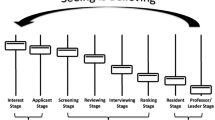Abstract
Background
Understanding the sociodemographic diversity and the experiences of trainees is imperative for developing an inclusive pediatric radiology workforce and improving patient outcomes.
Objective
To describe the sociodemographics of a pediatric radiology fellowship program over 25 years and examine potential associations with (a) a trainee’s sense of inclusion and belonging during training and (b) graduates’ ultimate choice/type of practice, progression to positions of leadership and mentorship of others.
Materials and methods
We designed and administered an online survey of sociodemographic diversity to graduates of one of the largest pediatric radiology fellowship programs in North America who graduated over the last 25 years. Respondents answered questions regarding (a) racial/ethnic identity, gender identity, sexual orientation, disability and other sociodemographics; (b) their sense of inclusion and belonging during fellowship training; and (c) their current type of practice, leadership and mentorship of others. Univariate analysis of variance (ANOVA) tests determined whether sociodemographic background was associated with inclusion/belonging during training, and with current type of radiology practice, leadership and mentorship. We assessed associations with covariates of interest and current leadership and mentorship roles using chi-square or Fisher exact tests. A heat map assessed individual and overall Likert scores across covariates.
Results
Seventy-six graduates completed the survey (46% response rate). Three percent of respondents identified as Black/African American, 7% as Latino/a/x, 45% as female, 4% as LGBTQ (lesbian, gay, bisexual, transgender, queer/questioning) and 5% as living with a disability at the time of fellowship. Graduates of international medical schools (P = 0.09) and osteopathic medical (DO) schools (P = 0.09), first-generation college graduates (P = 0.023), those with a first language other than English (P = 0.02) and U.S. military veterans (P = 0.048) reported significantly lower feelings of inclusion and belonging during training. Gender identity and sexual orientation did not correlate with feelings of exclusion or inequity. Graduates between 1996 and 2010 were significantly more likely to have filled a leadership role than those graduating after 2011 (P = 0.004) and were also significantly more likely to have mentored individuals underrepresented in medicine/pediatric radiology than those who graduated after 2011 (P = 0.04). None of the other sociodemographic variables demonstrated an association with leadership or mentorship, although 92.3% of those with a first language other than English served as a mentor compared to 68.2% of native English speakers (P = 0.097).
Conclusion
Efforts to promote a more diverse and inclusive workforce in pediatric radiology should be directed toward increasing numbers of fellows who are underrepresented in medicine (Black/African American, Hispanic/Latino/a/x) and providing a more inclusive training environment for first-generation college graduates, graduates of international and DO medical schools, fellows whose first language is not English, and veterans of the U.S. Armed Forces.

Similar content being viewed by others
References
Allen BJ, Garg K (2016) Diversity matters in academic radiology: acknowledging and addressing unconscious bias. J Am Coll Radiol 13:1426–1432
Nivet MA (2011) Commentary: diversity 3.0: a necessary systems upgrade. Acad Med 86:1487–1489
Committee on Pediatric Workforce (2013) Enhancing pediatric workforce diversity and providing culturally effective pediatric care: implications for practice, education, and policy making. Pediatrics 132:e1105–1116
Trent M, Dooley DG, Dougé J (2019) The impact of racism on child and adolescent health. Pediatrics 144:e20191765
Page KR, Castillo-Page L, Poll-Hunter N et al (2013) Assessing the evolving definition of underrepresented minority and its application in academic medicine. Acad Med 88:67–72
Chapman CH, Hwang WT, Both S et al (2014) Current status of diversity by race, Hispanic ethnicity, and sex in diagnostic radiology. Radiology 270:232–240
Association of American Medical Colleges (n.d.) Diversity in medicine: facts and figures 2019. AAMC webpage. https://www.aamc.org/data-reports/workforce/report/diversity-medicine-facts-and-figures-2019. Accessed 25 Apr 2022
Goske MJ, Lebowitz RL, Lieber M et al (2000) Pediatric radiologists: who we are and what we do. Results of a membership survey of the Society for Pediatric Radiology — 1999. Pediatr Radiol 30:581–585
Counter WB, Khurshid K, Jalal S et al (2020) Gender differences among academic pediatric radiology faculty in the United States and Canada. Acad Radiol 27:575–581
Pfeifer CM, Gokli A, Reid JR (2020) Advancing from gender equity to women in leadership in pediatric radiology. Pediatr Radiol 50:631–633
Krupat E, Camargo CA Jr, Strewler GJ et al (2017) Factors associated with physicians’ choice of a career in research: a retrospective report 15 years after medical school graduation. Adv Health Sci Educ Theory Pract 22:5–15
United States Census Bureau (n.d.) Quick facts: United States. https://www.census.gov/quickfacts/fact/table/US/PST045219. Accessed 25 Apr 2022
Albert MA (2018) #Me_who anatomy of scholastic, leadership, and social isolation of underrepresented minority women in academic medicine. Circulation 138:451–454
Gates GJ (2017) In U.S., more adults identifying as LGBT. Gallup. https://news.gallup.com/poll/201731/lgbt-identification-rises.aspx. Accessed 25 Apr 2022
Okoro CA, Hollis ND, Cyrus AC, Griffin-Blake S (2018) Prevalence of disabilities and health care access by disability status and type among adults — United States, 2016. MMWR Morb Mortal Wkly Rep 67:882–887
Acknowledgments
Valerie L. Ward, MD, MPH, is the principal investigator on a Boston Children’s Hospital Academy for Teaching and Educational Innovation and Scholarship Healthcare Professional Education Grant (2020–2021).
Author information
Authors and Affiliations
Corresponding author
Ethics declarations
Conflicts of interest
None
Additional information
Publisher’s Note
Springer Nature remains neutral with regard to jurisdictional claims in published maps and institutional affiliations.
Supplementary Information
Below is the link to the electronic supplementary material.
ESM 1
(DOCX 20.7 KB)
Rights and permissions
About this article
Cite this article
Breen, M.A., Melvin, P., Choura, J. et al. Diversity, equity and inclusion: a survey of pediatric radiology fellowship graduates from 1996 to 2020. Pediatr Radiol 52, 1749–1755 (2022). https://doi.org/10.1007/s00247-022-05438-z
Received:
Revised:
Accepted:
Published:
Issue Date:
DOI: https://doi.org/10.1007/s00247-022-05438-z




